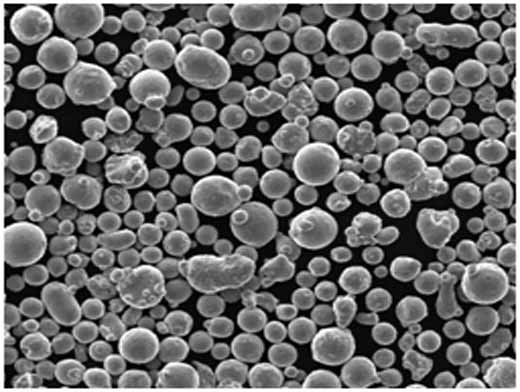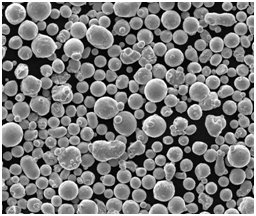Überblick über CuSnZn-Pulver
CuSnZn-Pulver, auch bekannt als Kupfer-Zinn-Zink-Pulver, ist ein spezielles Legierungspulver, das eine einzigartige Kombination aus mechanischen Eigenschaften, Korrosionsbeständigkeit und Vielseitigkeit in verschiedenen industriellen Anwendungen bietet. Diese Legierung besteht in der Regel aus einer ausgewogenen Mischung von Kupfer (Cu), Zinn (Sn) und Zink (Zn), die synergetisch zusammenwirken, um die Eigenschaften des Pulvers für Anwendungen in der Metallurgie, Beschichtungen, Sintern und Löten zu verbessern.
Die CuSnZn-Legierung zeichnet sich in der Kategorie der Metallpulver durch ein ausgewogenes Verhältnis von Festigkeit und Korrosionsbeständigkeit aus und ist daher in vielen Branchen beliebt, von der Automobilindustrie über die Luft- und Raumfahrt bis hin zu Elektronik und Bauwesen. Durch den Zusatz von Zinn gewinnt die Legierung an Festigkeit und Zähigkeit, während Zink die Verschleißfestigkeit und den Korrosionsschutz verbessert.
Wir werden uns näher mit den Arten, der Zusammensetzung, den Eigenschaften und den Anwendungen von CuSnZn-Pulver befassen. Wir werden auch spezifische Modelle, Spezifikationen und Vergleiche untersuchen, damit Sie verstehen, wo dieses Legierungspulver in Ihren Projekten eingesetzt werden kann.

Zusammensetzung und Eigenschaften von CuSnZn-Pulver
Die Zusammensetzung von CuSnZn-Pulver variiert je nach den gewünschten Eigenschaften geringfügig, aber die Hauptbestandteile bleiben Kupfer, Zinn und Zink in unterschiedlichen Verhältnissen. Jedes Metall trägt zu den einzigartigen Eigenschaften der Legierung bei:
| Komponente | Symbol | Typischer Bereich der Zusammensetzung (%) | Eingetragene Eigenschaften |
|---|---|---|---|
| Kupfer | Cu | 60-90% | Hohe thermische/elektrische Leitfähigkeit, Duktilität |
| Zinn | Sn | 5-20% | Festigkeit, Härte, Korrosionsbeständigkeit |
| Zink | Zn | 5-20% | Verschleißfestigkeit, erhöhte Festigkeit, niedrigerer Schmelzpunkt |
Verstehen der Rolle der einzelnen Komponenten
- Kupfer (Cu): Das Grundmetall Kupfer sorgt für die notwendige Duktilität, wodurch sich das Pulver leicht formen und bearbeiten lässt. Seine hohe elektrische Leitfähigkeit macht es auch für elektronische Anwendungen geeignet.
- Zinn (Sn): Der Zusatz von Zinn stärkt die Legierung, verbessert die Härte und erhöht die Korrosionsbeständigkeit, was sie ideal für mechanische Teile macht.
- Zink (Zn): Zink erhöht die Verschleißfestigkeit und trägt zur Senkung des Schmelzpunkts bei, was bei Anwendungen wie Hartlöten und Löten von Vorteil ist.
Eigenschaften von CuSnZn-Pulver
Die einzigartige Mischung von CuSnZn-Pulver führt zu den folgenden bemerkenswerten Eigenschaften:
| Charakteristisch | Einzelheiten |
|---|---|
| Korrosionsbeständigkeit | Hohe Korrosionsbeständigkeit in verschiedenen Umgebungen aufgrund des Kupfer- und Zinngehalts. |
| Stärke | Die Legierung ist zäh und langlebig und daher ideal für strukturelle und mechanische Anwendungen. |
| Verschleißfestigkeit | Zink verbessert die Verschleißfestigkeit, geeignet für stark beanspruchte Bauteile. |
| Wärmeleitfähigkeit | Hohe Wärmeleitfähigkeit dank Kupfer, nützlich bei wärmeempfindlichen Anwendungen. |
| Niedriger Schmelzpunkt | Niedrigerer Schmelzpunkt als reines Kupfer, dadurch bessere Löt- und Sintereigenschaften. |
Arten und Grade von CuSnZn-Pulver
Hier finden Sie einige der gängigsten Typen und spezifischen Modelle von CuSnZn-Pulver, die jeweils für bestimmte industrielle Anforderungen optimiert sind. Diese Pulver unterscheiden sich in Bezug auf die Partikelgröße, die Zusammensetzung und die Anwendung.
| Name des Modells | Zusammensetzung (Cu-Sn-Zn %) | Anmeldung | Einzigartige Eigenschaften |
|---|---|---|---|
| CuSn10Zn2 | 88-10-2 | Dekorative Beschichtungen, Schmuck | Ausgezeichnete Korrosionsbeständigkeit |
| CuSn5Zn5 | 90-5-5 | Elektrische Kontakte, reibungsarme Beschichtungen | Hohe elektrische Leitfähigkeit |
| CuSn8Zn4 | 88-8-4 | Lager, Buchsen | Verbesserte Verschleißfestigkeit |
| CuSn6Zn3 | 91-6-3 | Zahnräder, kleine Maschinenteile | Ausgewogene Festigkeit und Bearbeitbarkeit |
| CuSn9Zn1 | 90-9-1 | Hartlöten und Löten | Niedrigerer Schmelzpunkt |
| CuSn7Zn2 | 91-7-2 | Komponenten für die Luft- und Raumfahrt, Wärmetauscher | Hohe Wärmeleitfähigkeit |
| CuSn12Zn1 | 87-12-1 | Automobilteile, Verbindungselemente | Erhöhte Zähigkeit |
| CuSn3Zn5 | 92-3-5 | Industriearmaturen, Ventilsitze | Gute Beständigkeit gegen abrasiven Verschleiß |
| CuSn11Zn4 | 85-11-4 | Schiffsausrüstung, Propeller | Hervorragende Korrosionsbeständigkeit in Wasser |
| CuSn15Zn2 | 83-15-2 | Stark beanspruchte mechanische Teile | Hohe Härte und Zugfestigkeit |
Jedes dieser Modelle bietet leicht unterschiedliche Stärken, so dass es entscheidend ist, den richtigen Typ für den jeweiligen Bedarf zu wählen.









Anwendungen von CuSnZn-Pulver
Dank seiner Vielseitigkeit eignet sich CuSnZn-Pulver für ein breites Spektrum von Anwendungen:
| Anmeldung | Einzelheiten |
|---|---|
| Automobilbranche | Lager, Buchsen, Zahnräder, wegen ihrer Verschleißfestigkeit und Haltbarkeit. |
| Luft- und Raumfahrtindustrie | Komponenten in Motoren und Konstruktionsteilen, die eine hohe Festigkeit und Korrosionsbeständigkeit erfordern. |
| Elektronik | Elektrische Kontakte, Steckverbinder und Wärmeableitungsmaterialien. |
| Meerestechnik | Propeller, Schiffsarmaturen, wegen der hervorragenden Korrosionsbeständigkeit. |
| Industrielle Fertigung | Lager, Buchsen, reibungsarme Beschichtungen für Maschinen. |
| Schmuck und dekorative Kunst | Wird für ästhetische Beschichtungen und Schmuck aufgrund seiner attraktiven Farbe und Haltbarkeit verwendet. |
| Hartlöten und Löten | Legierungen mit niedrigem Schmelzpunkt, die eine starke Verbindung in Metallverbindungen ermöglichen. |
| Wärmetauscher | Eine hohe Wärmeleitfähigkeit ist für eine effiziente Wärmeübertragung von Vorteil. |
Spezifikationen der CuSnZn-Pulvermodelle
| Modell | Partikelgrößenbereich (µm) | Dichte (g/cm³) | Schmelzpunkt (°C) | Härte (HV) |
|---|---|---|---|---|
| CuSn10Zn2 | 20-45 | 7.6 | 980 | 120 |
| CuSn5Zn5 | 15-50 | 7.7 | 990 | 110 |
| CuSn8Zn4 | 25-60 | 7.5 | 970 | 130 |
| CuSn6Zn3 | 10-40 | 7.65 | 980 | 125 |
| CuSn9Zn1 | 5-30 | 7.8 | 950 | 115 |
| CuSn7Zn2 | 20-60 | 7.7 | 960 | 130 |
| CuSn12Zn1 | 15-45 | 7.6 | 940 | 140 |
| CuSn3Zn5 | 20-55 | 7.75 | 930 | 110 |
| CuSn11Zn4 | 25-70 | 7.6 | 920 | 135 |
| CuSn15Zn2 | 10-50 | 7.5 | 910 | 145 |
Vorteile und Beschränkungen von CuSnZn-Pulver
| Merkmal | Vorteile | Beschränkungen |
|---|---|---|
| Korrosionsbeständigkeit | Hochgradig korrosionsbeständig in maritimen und industriellen Umgebungen. | Weniger beständig als einige andere Legierungen in extrem sauren Bedingungen. |
| Verschleißfestigkeit | Ausgezeichnete Verschleißfestigkeit, insbesondere mit Zinkzusatz. | Ein höherer Zinkgehalt kann bei einigen Anwendungen zu Sprödigkeit führen. |
| Wärmeleitfähigkeit | Effiziente Wärmeübertragung, nützlich für Elektronik und Wärmetauscher. | Nicht so hoch wie reines Kupfer oder Kupfer-Aluminium-Legierungen bei thermischen Anwendungen. |
| Festigkeit und Härte | Bietet ein gutes Gleichgewicht zwischen Festigkeit und Härte, ideal für tragende Teile. | Kann weicher sein als Stahllegierungen, was den Einsatz in extrem hoch beanspruchten Anwendungen einschränkt. |
| Bearbeitbarkeit | Leicht bearbeitbar mit Standardwerkzeugen, was die Produktionskosten senkt. | Ein höherer Zinn- oder Zinkgehalt kann die Bearbeitbarkeit aufgrund erhöhter Sprödigkeit verringern. |
| Kosten | Im Allgemeinen günstiger als reines Kupfer oder spezielle Legierungen. | Die Preise schwanken mit der Marktnachfrage nach Kupfer, Zinn und Zink. |
Führende Anbieter und Preisinformationen
| Anbieter | Land | Durchschnittspreis (pro kg) | Grades verfügbar |
|---|---|---|---|
| ABC Metalle | USA | $25 – $40 | CuSn10Zn2, CuSn5Zn5 |
| Global Alloy Ltd. | Deutschland | $28 – $45 | CuSn8Zn4, CuSn6Zn3 |
| Legierung Welt | Japan | $30 – $42 | CuSn7Zn2, CuSn12Zn1 |
| Metalle R Us | UK | $27 – $38 | CuSn3Zn5, CuSn11Zn4 |
| CopperCraft | China | $20 – $35 | CuSn9Zn1, CuSn15Zn2 |

FAQ
| Frage | Antwort |
|---|---|
| Wofür wird CuSnZn-Pulver verwendet? | Aufgrund seiner Korrosionsbeständigkeit wird es häufig in der Automobil-, Luft- und Raumfahrt-, Marine- und Elektronikindustrie eingesetzt. |
| Kann CuSnZn-Pulver reines Kupfer ersetzen? | In vielen Fällen, ja. Es bietet eine ähnliche Wärmeleitfähigkeit, aber eine höhere Festigkeit und Korrosionsbeständigkeit. |
| Was ist die typische Preisspanne? | Die Preise schwanken je nach Zusammensetzung und Anbieter zwischen 20 – 45 $ pro kg. |
| Ist CuSnZn-Pulver zum Löten geeignet? | Der niedrige Schmelzpunkt macht es zu einer ausgezeichneten Wahl für Hart- und Weichlötanwendungen. |
| Was ist der Hauptvorteil dieser Legierung? | Die Legierung bietet eine ausgewogene Mischung aus Festigkeit, Verschleißfestigkeit und Korrosionsbeständigkeit. |

